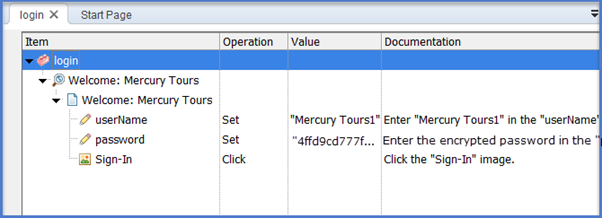Overview of Keyword View: UFT Keyword View facilitates user to see the steps of created actions or components in a modular, table-like format. User can generate and change steps by selecting items and operations in the Keyword View. Facilitate users to see a description of the action or component in understandable format and those descriptions (used as instruction for required manual testing project) are helpful for manual testing.
Each step displays in a row and automatically get documented as user complete it. It does not require any programming knowledge to work on it. User can use the Keyword View to add new steps to an action or component and to view, change, and debug present steps.
Business Components of Keyboard view.
The Keyword View for components provides number of options specific to the component and facilitates the formation of business components. In Keyword View, all component steps display in same hierarchical level. It becomes easier and spontaneous for Subject Matter Experts to generate and manage their business components in ALM. These components can also include comment steps that facilitate users and Subject Matter Experts to enter manual steps and informational separators in a business component.
Keyword View Elements
These are the keyword view
Elements,
- Item for actions
- Item for components
- Operation
- Value
- Assignment for actions
- Output for components
- Comment
- Documentation
1) Item for action: The item on which the steps can be performed.These items are,
- Object repository’s test object
- Utility object
- Function call
- Statement like; a Dim statement
- Steps generated by the Step Generator.
The Item column displays an icon based tree hierarchical where at the top action is placed. Steps performed on the object displays with the same object.
2) Item for components: The item on which the steps can be performed.These items are,
- Object repository’s test object
- An user-defined function (Operation)
- Comment.
Given below figure,shows test objects available for step in the Item list.
3) Operation: Operations are basically methods, functions, or properties (or sub-procedures for components) available next the Item column and works on Selected Item.
In actions,the Operation column displays the default operation.
In case of components, the Operation column displays the operation performed on Item.If component associates a function library, the functions from that function library are accessible from the column.
4) Value: Anargument value of the Item.For predefined values argument contains drop down list and user cannot manually enter a value in this box.
The value cell that accept parameters, displays parameters with the parameterization icon. Click this icon to open the Value Configuration Options Dialog Box. Similarly, Value cell of a checkpoint step displays with the checkpoint properties icon , when user click on this icon, the relevant Checkpoint Properties dialog box opens.
In case of components, an argument value totally depends on the selected options; it can be a constant, a local parameter, or a component parameter. Local parameter in component: A local parameter works on the business component, only. It is planned to use in a single step or between component steps.
Component parameter in component:It is a parameter that can be retrieved by any component in the ALM project.
5) Assignment only for actions:The assignment of a value to or from a variable. For example, “Store in cCols”will place the return value of the current step in a variable called cCols. Can choose either “Store in” or “Get from”, depends on whether you want to retrieve the value from a variable or store the value in a variable.
Store in X. Value is equivalent to an X = <step> line in the Editor.
Get From X. Value is equivalent to a <step> = X line in the Editor.
6) Output only for components: The parameter in which output values for the step are stored
7) Comment:
In case of actions: A free editable text box to add any information about the step. In the Editor, it displays as inline comments.
In case of components: A manual step or other free textual notes between steps. A comment is displayed as an entire row (not in a column).
8) Documentation: Automatic documentation in read-only mode of what the step does in an easy-to-understand sentence.
⇓ Subscribe Us ⇓
If you are not regular reader of this website then highly recommends you to Sign up for our free email newsletter!! Sign up just providing your email address below:
Happy Testing!!!
